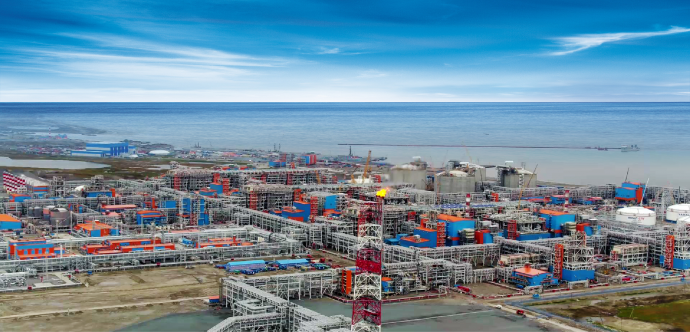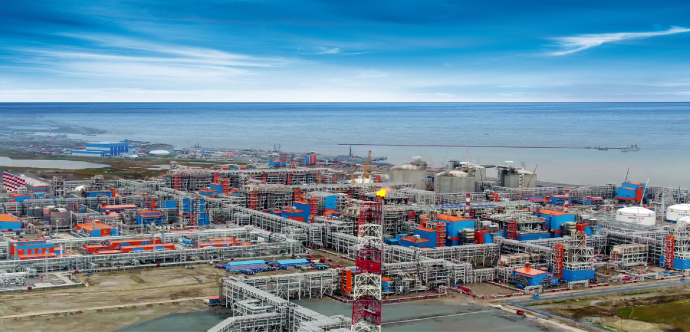
BEIJING, Dec. 3 (Xinhua) -- Energy cooperation is one of the key areas for Belt and Road construction. With the joint efforts of China and countries along the Belt and Road, cooperation in energy field has been continuously expanding and improving in terms of scale and quality in the past five years. Belt and Road energy cooperation has become an important platform for all participants, injecting impetus for mutual development.
-- Energy cooperation widening
In this July, the first ship carrying liquefied natural gas (LNG) to China from the Yamal LNG project, a major Sino-Russian energy cooperation project, arrived at CNPC Rudong receiving station in Jiangsu Province via the Northeast Passage of the Arctic shipping routes, marking a new chapter of transporting LNG from Yamal to China.
The Yamal project, the first large energy cooperation project implemented in Russia for the implementation of Belt and Road Initiative, powers the development of Russia's energy sector while enriching China's clean energy supply and accelerating the optimization of its energy mix.
Over the past five years, China has advanced cooperation in oil and gas production across Central Asia, Middle East, Africa and the Americas, and established electric power interconnection with Russia, Mongolia, Laos, Vietnam and Myanmar. A number of iconic projects have been launched, upgrading cooperation in energy investment, technology, equipment and service.
With the joint efforts of governments, enterprises and think tanks, energy cooperation has become a highlight for Belt and Road construction, according to an official with National Energy Administration of China.
China has established 24 bilateral energy cooperation mechanisms with Belt and Road countries over the past five years. More than 100 energy cooperation documents have been signed. Moreover, China has newly established or joined in ten multilateral cooperation mechanisms, and conducted joint research in energy with Russia, Pakistan and Mongolia.
-- Energy construction fuels development
The Csathy Val thermal power station completed last year is the first large power generation project put into operation under the China-Pakistan Economic Corridor. Its annual generating capacity will reach 9 billion kWh, which could effectively relieve power shortage there.
In the past five years, China has kept improving energy infrastructure and energy access in relevant countries, and helped them build a green, low-carbon, clean and efficient modern energy system to power economic and social development.
Advocating the principle of common development with mutual benefits and win-win results, China has deepened cooperation in energy and resources, and improved its oil and gas import channels. At the same time, China propels the development of global energy interconnection network, providing relevant countries with technologies, equipment, engineering services and other support to boost the development and utilization of global clean energy and advocate green and low-carbon ways to meet power demands.
The booming international cooperation in the energy sector has led to the upgrading of the energy industry in relevant countries. Through various ways such as project contracting, greenfield investment, joint venture and M&A, China has pushed forward the development of a number of new energy power stations overseas, actively pursued new energy capacity cooperation, and driven the green and low-carbon transformation of the energy industry in relevant countries.
-- Energy projects bring closer people-to-people ties
Yanbu, a beautiful and tranquil town on the coast of Red Sea in western Saudi Arabia, is home to the Yanbu Aramco Sinopec Refining Company Ltd., a joint venture of Sinopec Group and Saudi Aramco.
"We have brotherhood with our Chinese colleagues. We help and care for each other, "said Hassam, PR manager of the company.
Chinese enterprises also fulfill their overseas corporate social responsibilities (CSR). Specifically, they build schools, hospitals and roads for the countries where they operate, integrate themselves into the local industrial chains, provide more and better training programs to local employees, and offer plenty of tax revenues and jobs to these countries.
Taking China National Petroleum Corporation (CNPC) as an example: In the past five years, it has invested more than 300 million U.S. dollars in its overseas business to perform CSR in Belt and Road countries, providing jobs to over 100 thousand locals; petroleum cooperation projects have benefited more than 3 million locals, which accounted for over 85 percent of total employees in these projects. CNPC has trained tens of thousands of technicians and management talents in petroleum industry for these countries.
Energy infrastructure is important bedrock for our survival. As energy supply is a public utility, high-quality energy cooperation projects can benefit the people in the countries concerned. After Chinese companies invested in the National Grid Corporation of the Philippines (NGCP), the performance indicators of the power grid continue to rise, and the quality of power supply becomes much higher. This program is highly appreciated by the local government, the media, and the public.
Meanwhile, Chinese enterprises attach great importance to environmental protection during the construction and operation of the projects, promote the development and utilization of clean energy, while strictly controling the emission of pollutants and greenhouse gases to better protect the waters and mountains in these countries. (Edited by Niu Huizhe, niuhuizhe@xinhua.org)
The article was first published on Belt & Road Weekly, a newsletter focusing on the progress of the Belt & Road construction.




 A single purchase
A single purchase









